Productivity, Communication and Collaboration Tools: Pricing and Market Share Breakdown

Work is an important part of our life.
Our jobs are essential to meeting our personal, career, and financial needs. We strive to be productive and show our full potential at work.
To do our best in today's work life, we need the tools we rely on to get things done, work together, and stay in touch with our teams. These tools have become more important than ever and today, in this article, we will discuss how much they are used, how big they are in the market, and see how they are changing the way we work together!
What are productivity tools?
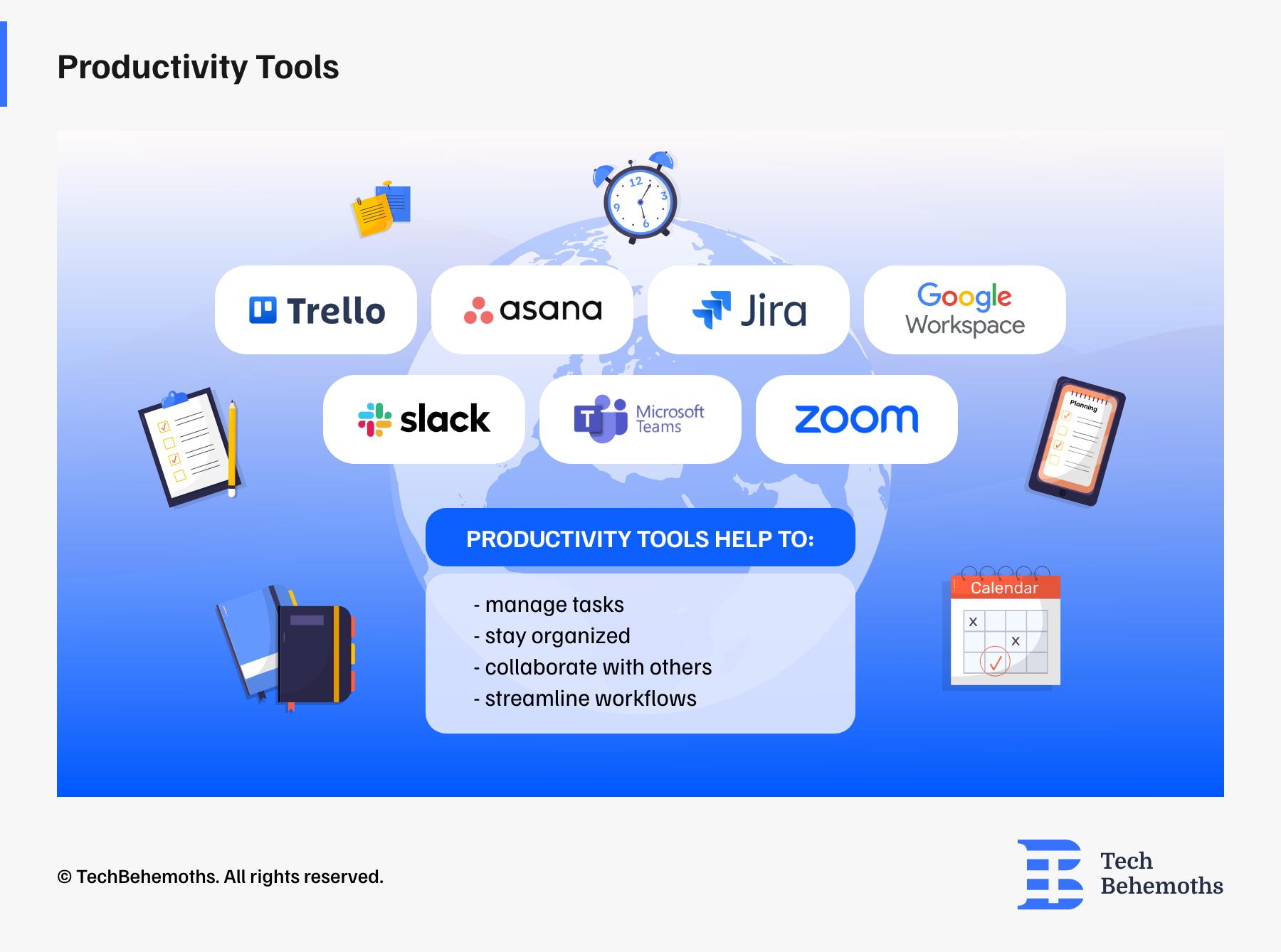
Productivity tools, as the name already suggests, help us stay productive and work more efficiently.
These can be software applications or websites designed to help users manage tasks, stay organized, collaborate with others, automate repetitive tasks, and streamline workflows.
Depending on your needs, you can choose the tools that are more suitable for you.
Just answering:
- What types of tasks do you need to manage?
- What devices do you use?
- Do you need to collaborate with others?
- What are your preferences?
- What is your budget?
There are a variety of productivity tools, but they generally fall into several categories:
- Collaboration tools
- Team Communication tools
- Project management tools
- Office tools
- Time tracking tools, etc.
An important thing is not to use too many of them, it's better to focus on using a few tools that you feel comfortable with and work well for you.
Collaboration Tools - Market Size/Share
Collaboration tools are about collaboration within the team.
Collaboration tools are like digital helpers that make it easy to work together. It's like having a digital meeting room where everyone can join to share ideas, files, and messages and get things done together without being in the same office.
Looking ahead, the collaboration tools market is poised for substantial growth. By the end of 2023, the collaboration tools market is expected to reach USD 39,407.4 million and a forecast of USD 116,338.4 million by 2033, growing at a solid 11.4% each year.
Therefore, it is important to choose the right tools to energize your team and manage your projects effectively. Further, we’ll discuss which collaboration tools are preferred by teams and are also making a big impact in the market.
Google Workspace
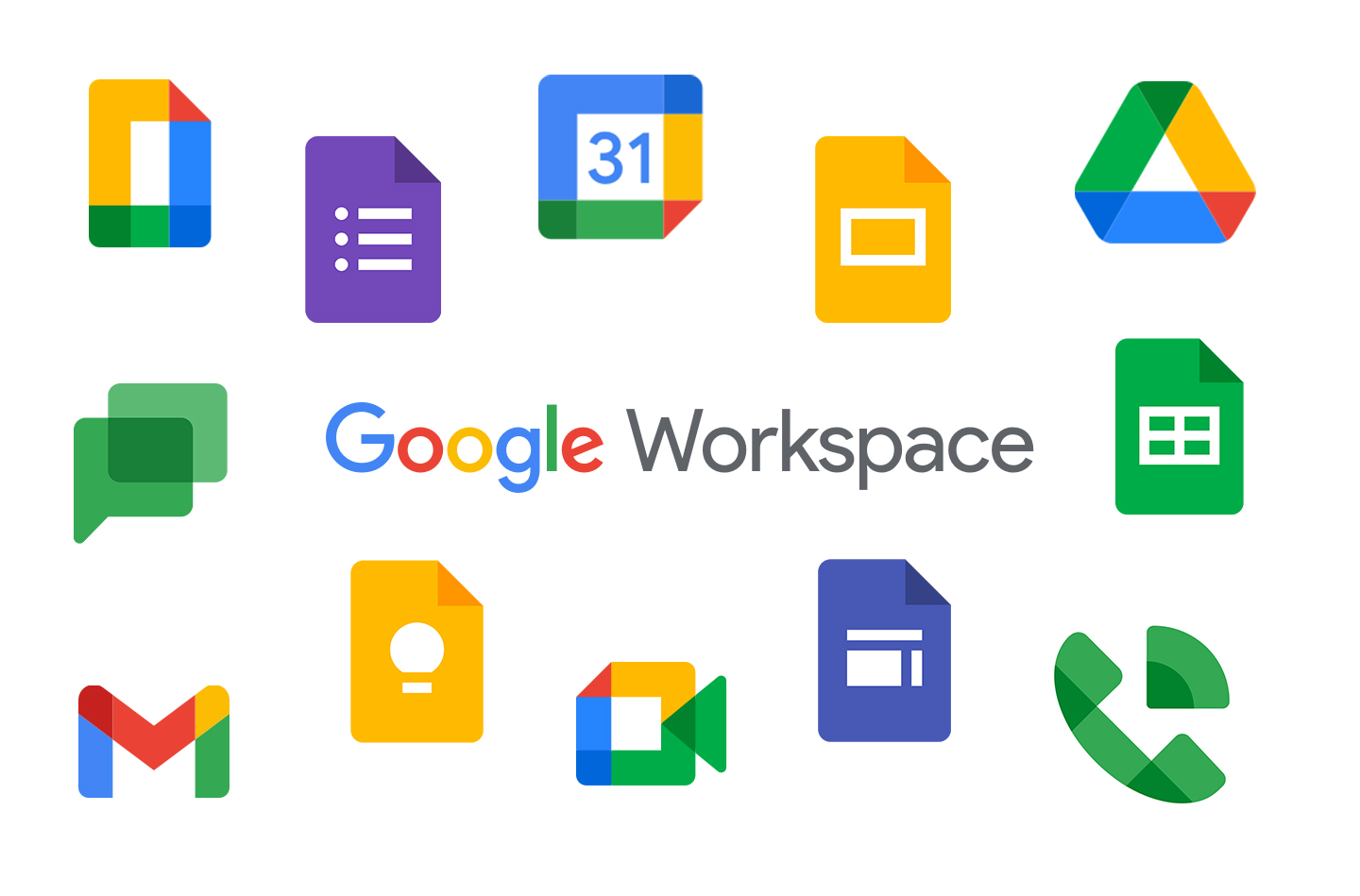
Google Workspace is a suite of productivity tools, software, and applications offered by Google, that includes:
- Gmail
- Calendar
- Drive
- Docs
- Sheets
- Slides
And more.
Additionally, it includes Google Chat, a real-time messaging platform that allows teams to communicate and collaborate easily.
Google Workspace is one of the leading collaboration tools on the market, with a market share of 68.77%. It is a popular choice for businesses of all sizes, and it is estimated that there are over 3 billion Google Workspace users worldwide.
Google Workspace's popularity is due to its many features:
- An affordable collaboration tool. You may choose from a variety of pricing plans, and there is even a free plan for businesses with up to 10 users.
- It's cloud-based in nature. This means it can be accessed from any device with an internet connection, making it a convenient and flexible option.
- User-friendly - it is designed to be easy to use, even for users who are not familiar with productivity software.
- Integration with other Google products: e.g. Google Workspace integrates with Gmail and Google Calendar, allowing users easy file access and collaboration.
Did you know that Google Workspace already has users in 190 countries on average, a Google Workspace user spends about 2 hours a day on the platform. Guess what? Google Workspace is expected to continue its growth and increase its market share by introducing new features and expanding its presence in new markets. It seems like everybody is waiting for more.
Jira
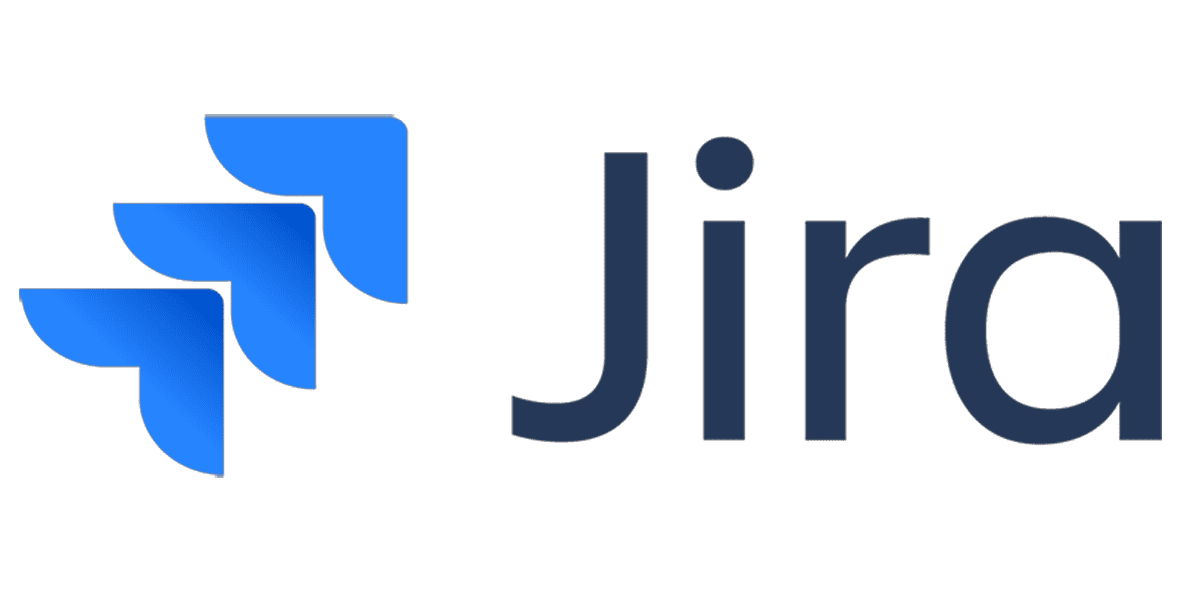
Jira is a powerful collaboration tool that can help you manage your projects and is also a good option for teams of all sizes, from small businesses to large enterprises. According to Atlassian, Jira is used by over 65.000 companies and organizations worldwide to collaborate more effectively and achieve their goals.
Jira is based on the concept of issues, which are tasks that need to be completed. Issues can be assigned to team members, tracked for progress, and linked to other issues. Also, the team collaborates through commenting and mentions.
Jira is used by over 10 million people worldwide, making it a popular tool with a market share of 36.5%.
It's a popular choice, especially for software development teams, but it can be used for other types of projects as well. That is, if a software development team can use Jira to track bugs, feature requests, and tasks, then a marketing team can use Jira to plan and execute marketing campaigns, and on the other hand, customer service can use Jira to track customer issues and support tickets.
So, the key features of Jira are:
- Tracking issues such as bugs or feature requests.
- Workflows, assignments, and automatic completion of tasks.
- Kanban boards visually represent the ongoing tasks and progress of your work.
- Generated reports to track progress and measure your team's performance.
- Easy connection with other tools, such as Slack or GitHub.
In this way, you achieve improved team collaboration, increased productivity, reduced errors, and better decision-making.
Asana
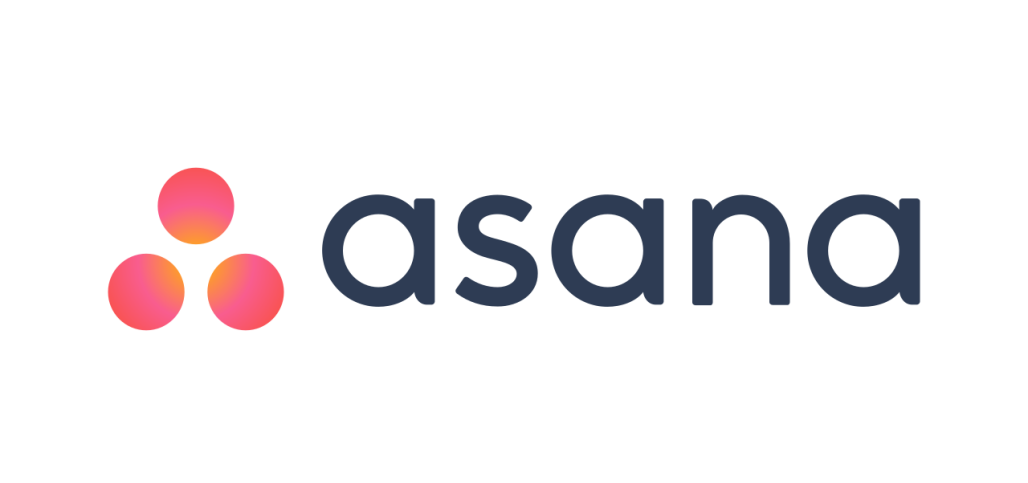
Asana is another management and collaboration tool that allows teams to track their work, plan projects, create and assign tasks, communicate and collaborate with each other. It's available as a web app, mobile app, and desktop app and suits teams of all sizes.
Over 100,000 organizations and millions of teams worldwide rely on Asana to streamline their work. For 2023, Asana anticipates revenues between $541.0 million and $543.0 million, reflecting a robust year-over-year growth of 41%. At the same time, the company's market share is estimated to be around 2%, but it is expected to increase in the coming years.
Asana helps teams to:
- Improve communication by sharing information and collaborating on tasks
- Increase productivity by providing a clear overview of work and deadlines
- Reduce risk by identifying and tracking potential problems early on.
- Improve customer satisfaction by ensuring that projects are completed on time and within budget.
So, Asana is a successful collaboration tool due to its easy-to-use interface, robust features, and cloud-based solution, is accessible from anywhere and can integrate with a variety of other productivity tools such as Slack, Google Calendar, and Dropbox.
Trello

Trello is a collaboration tool for task management. It helps teams to organize and track their work in a visual way. It uses a board system divided into lists that represent the different stages of a project and an intuitive system of cards used to represent individual tasks that can be moved between lists as they progress.
Trello is a great collaboration tool where team members can see all of the work happening on a project in one place, these make it easier to communicate and collaborate on it. They can add comments to cards, attach images, documents, and videos, or create checklists to track the progress of a task.
Trello is particularly popular among small and medium-sized businesses. It’s best for marketing teams that look for simple task management solutions or other teams like product development, sales, and customer support that need a simple, scalable task management system.
While its exact market share varies depending on the source, it is estimated to hold around 0.65% of the global project collaboration software market, with an estimated 1.2 million active users. This means that it is one of the smaller players in the market, but a a popular tool with a large user base.
Trello is easy to use, and it makes it easy to organize, track, and collaborate on work.
But at the same time, it has large competitors. To stay ahead, it has to come up with new ideas and features to keep its customers happy and its market share intact.
Team Communication Tools - Market Size/Share
Team communication tools are very important for keeping teams organized and connected, especially in today's hybrid or even remote work environment.
Communication tools are about communication within the team.
Instant messaging, file sharing, and video conferencing - all help to keep everyone on the same page. This way we gain increased productivity, improved collaboration, and increased employee satisfaction. It’s demonstrated employees who feel connected to their team are more likely to be satisfied with their jobs. Last but not least team communication tools save money and time by reducing the need for in-person meetings and travel.
The market for team communication tools is growing rapidly. According to Statista, in 2023, the global team communication market was valued at US$ 14.65 billion. The market is expected to grow at a CAGR of 2% from 2023 to 2028, resulting in a market size of USD 16.12 billion by 2028.
Let’s explore some of the most popular team communication tools and see their market share!
Microsoft Teams
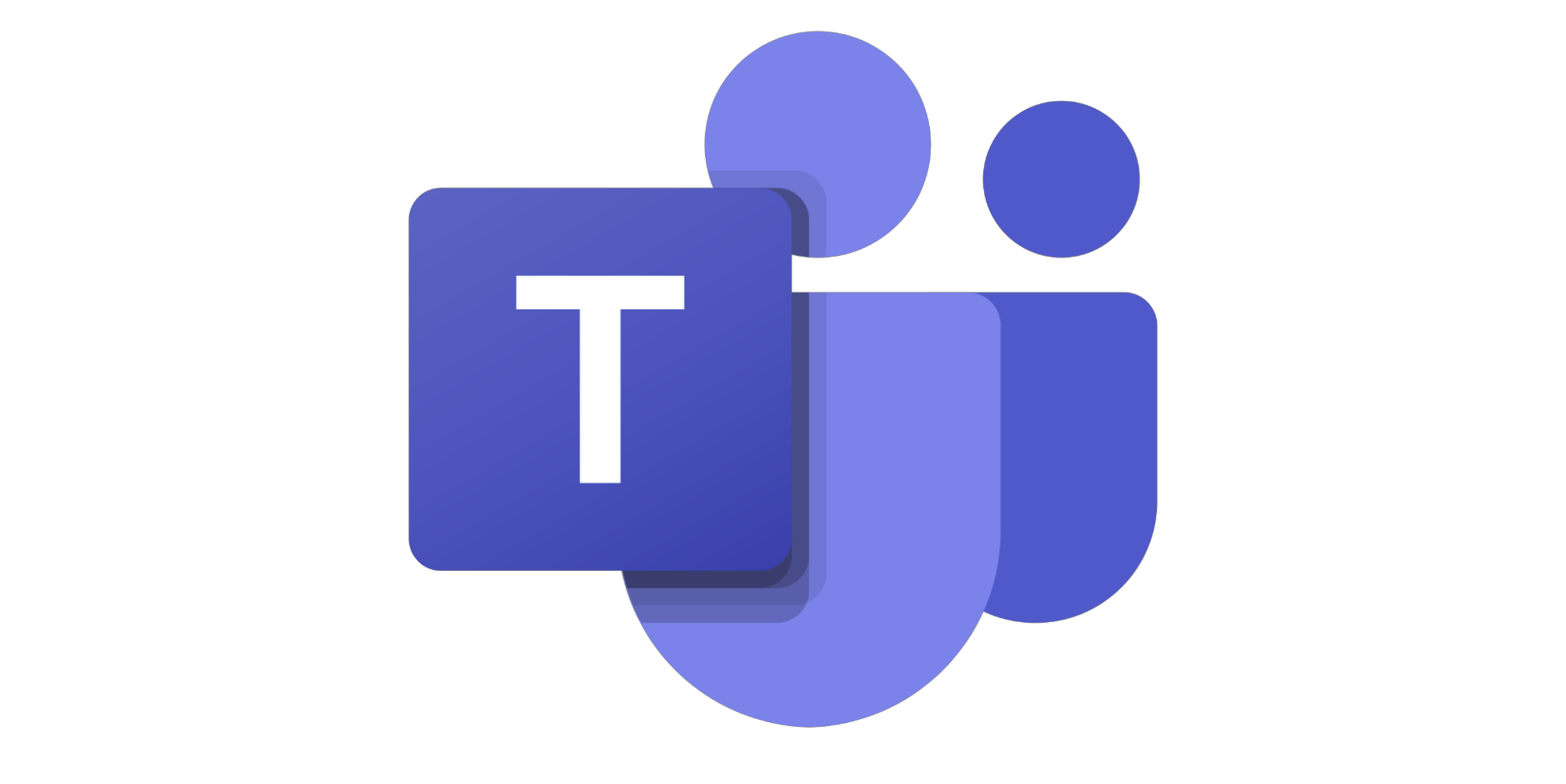
Microsoft Teams is one of the most popular communication tools in the world, with over 270 million monthly active users, and it is growing at a rate of over 40% year-over-year.
Microsoft Teams is a communication platform that combines messaging, video conferencing, file sharing, and app integration. So users can
- chat with each other
- share files and stay up-to-date on project progress
- have video conferences and face-to-face conversations with colleagues who are located in different parts of the world
- integrates with other Microsoft applications, such as Office 365, SharePoint, and Dynamics 365. This makes it easy to access and share information from these applications within Teams.
All of these help teams communicate whether they are working in the office, at home, or on the go.
Microsoft Teams' market share increased to $23.4 billion, a 32% growth from the previous quarter, and is expected to grow more, reaching a value of USD 35,7 billion by 2027.
Microsoft Teams is available at a variety of prices to meet the needs of businesses of all sizes.
Currently accessible in 181 countries and supports 48 languages. This makes it easy for businesses to find and connect with employees, partners, and customers from all over the world.
Slack
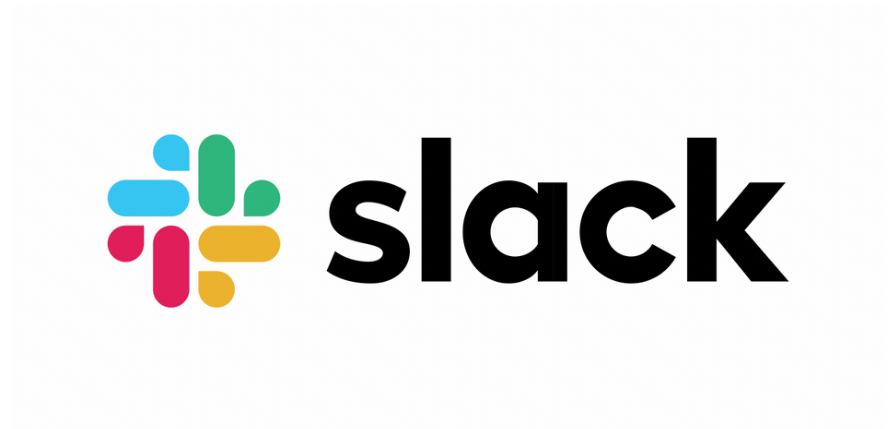
Slack is another popular communication tool for companies of all sizes, with 32.3 million daily active users in 2023, a number expected to grow to 47.2 million by 2025.
Slack helps teams stay connected through its core features, such as real-time communication, channel conversations, private messaging, and file sharing. All of this helps teams to be more productive, get feedback from the team more easily, and why not reduce the amount of emails that team members receive.
Another great thing is the Slack notification system that ensures users are always up to date with the latest conversations.
Slack has a market share of 21.21% in the communication market and is used by over 100,000 organizations worldwide, including 77 Fortune 100 companies.
Slack is synonymous with team communication, it's easy to use, and with so many user-favorite features, it really is a great choice.
Zoom

Zoom is a cloud-based video conferencing tool that allows people to connect through video, voice, and instant messaging. It's perfect for remote meetings, webinars, and online courses, making it valuable for companies, schools, and individuals who need to communicate from different locations.
According to Statista, Zoom is the leading video conferencing software with the largest video conferencing market share - about 57%, followed by Microsoft Teams with about 28% market share. Zoom's revenue for 2022 was $4.3 billion, which is a 7.3% increase from the previous year.
What makes Zoom a great communication tool?
- High-quality video and audio, even on low bandwidth connections.
- Screen sharing is great for presentations and demos.
- Whiteboarding is used to draw and annotate during your meetings.
- Breakout rooms allow split meetings for more focused discussions.
- Recordings, for later playback.
- It’s easy to use.
- Security features are used to protect your meetings.
Zoom is one of the fastest-growing apps, today with about 300 million daily active users in meetings.
In this sense it is well understood that productivity tools bring us many advantages, but do they also have disadvantages? Let's explore this part further.
Pros and Cons of Productivity Tools
Like anything else, productivity tools have both good and bad sides. To make it clear, let's list them and see what they are.
Pros
-
Improved Communication
Instant messaging and video conferencing help teams communicate and make decisions in real-time, minimizing delays.
-
Easier Project and Task Management
Productivity tools bring everything from your project into one place – documents, files, and feedback. So you can create, assign, and track tasks, making sure everyone knows what they're responsible for and that things move smoothly and on time.
-
Better Remote Work
Working from home is made easier with productivity tools that create a virtual space where you can chat with colleagues, manage documents, and work together.
-
Cost Savings
By using productivity tools, you can save money as people work together from different locations without spending as much on travel and office space.
Cons
-
Reduced Face-to-Face Interaction
Using digital tools too much instead of talking in person might make it harder for teams to be creative, share ideas, and miss out on the non-verbal signals that help them understand each other.
-
Tech Challenges
Dependence on tech can cause disruptions, like glitches and downtime. Learning new tools may slow us down. We also need to make sure our sensitive info stays safe from unauthorized access.
-
Distracting Notifications
Getting too many notifications and messages from productivity tools can be annoying and make it hard to stay focused on what you're doing.
4. Extra Costs
Some productivity tools come with subscription fees or additional costs for extra features. If you have a limited budget, you might not be able to use all of them.
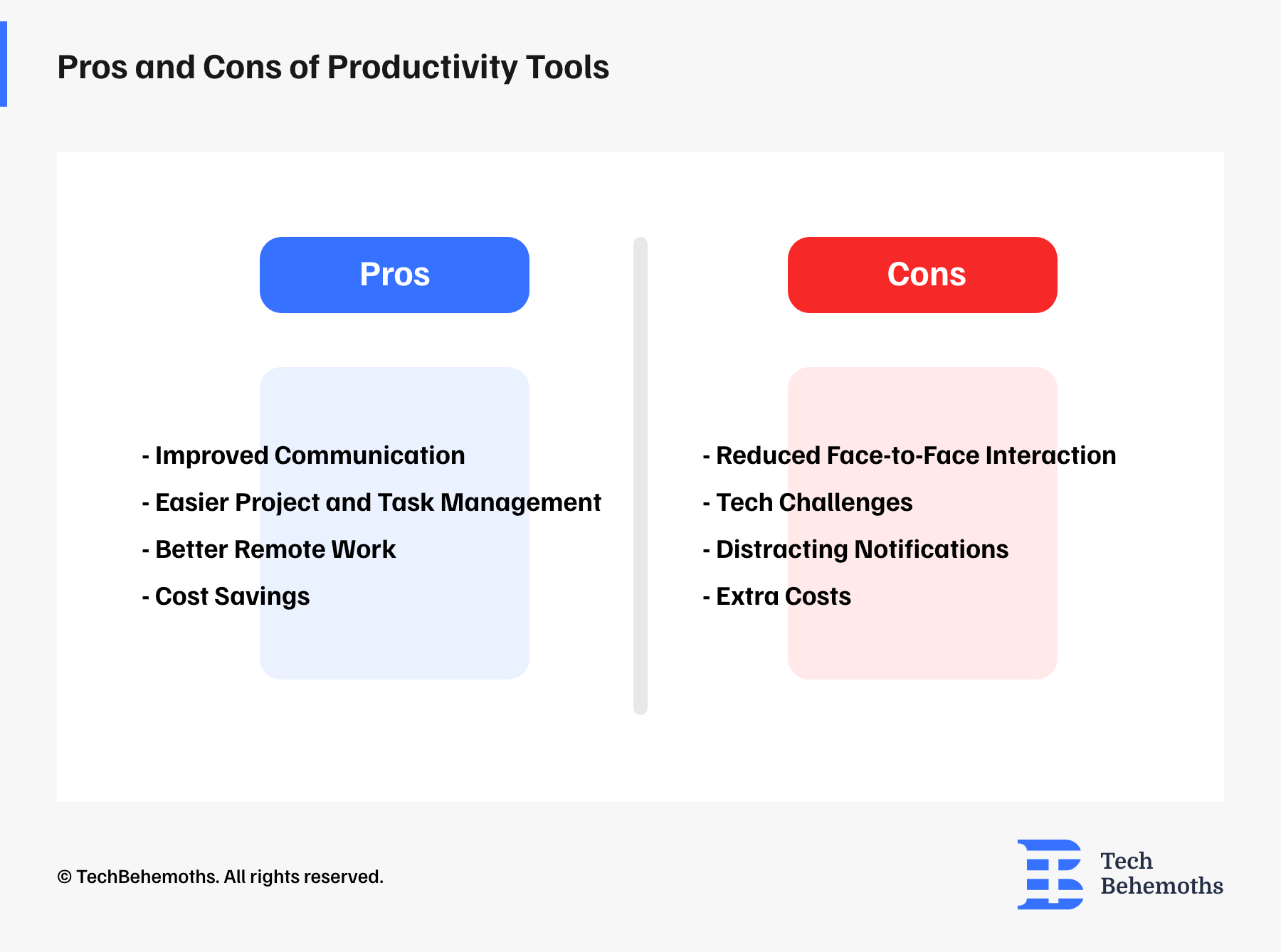
Now that we know the pros and cons of productivity tools, we can freely decide whether or not they are right for us. But until then, let's keep an eye on their prices as well.
Productivity Tools Pricing
The productivity pricing option depends on the number of users and features required. Each of the tools above offers free and paid plans.
When you can benefit from a free plan and when do you need to pay?
The free plan includes Gmail, Drive, Docs, and more, good for personal use or small teams, but if you need extra features and storage, paid plans start at $6/month per user for basic and go up to $18/month per user for advanced options
The free plan provides basic project management capabilities and is suitable for small teams. Paid plans start at $8 per user per month for Standard and go up to $16 per user per month for Premium.
The free plan provides basic task management and collaboration tools for up to 15 users. Paid plans start at $10.99 per user per month for Premium and go up to $24.99 per user per month for Enterprise.
The free plan includes basic project management features for up to 10 boards and unlimited cards, lists, and members. Paid plans start at $5 per user per month for Standard and go up to $17.50 per user per month for Enterprise.
Microsoft Teams has a free version for everyday personal use. However, it doesn't include some features that come with the premium version. If you want the extra features, you can get Microsoft 365. The prices start at $4 per person each month for the Essentials Plan. If you go for the Business Standard plan, it's $12.5 per person per month.
Slack offers a free plan with basic messaging and collaboration tools for up to 10,000 members. Paid plans start at $7.25 per user per month for Pro and go up to $12.50 per user per month for Business+.
Zoom offers a free plan with basic video conferencing features for up to 100 participants and 40-minute meetings. Paid plans start at $13.99 per month for Pro and go up to $18.99 per month for Business.
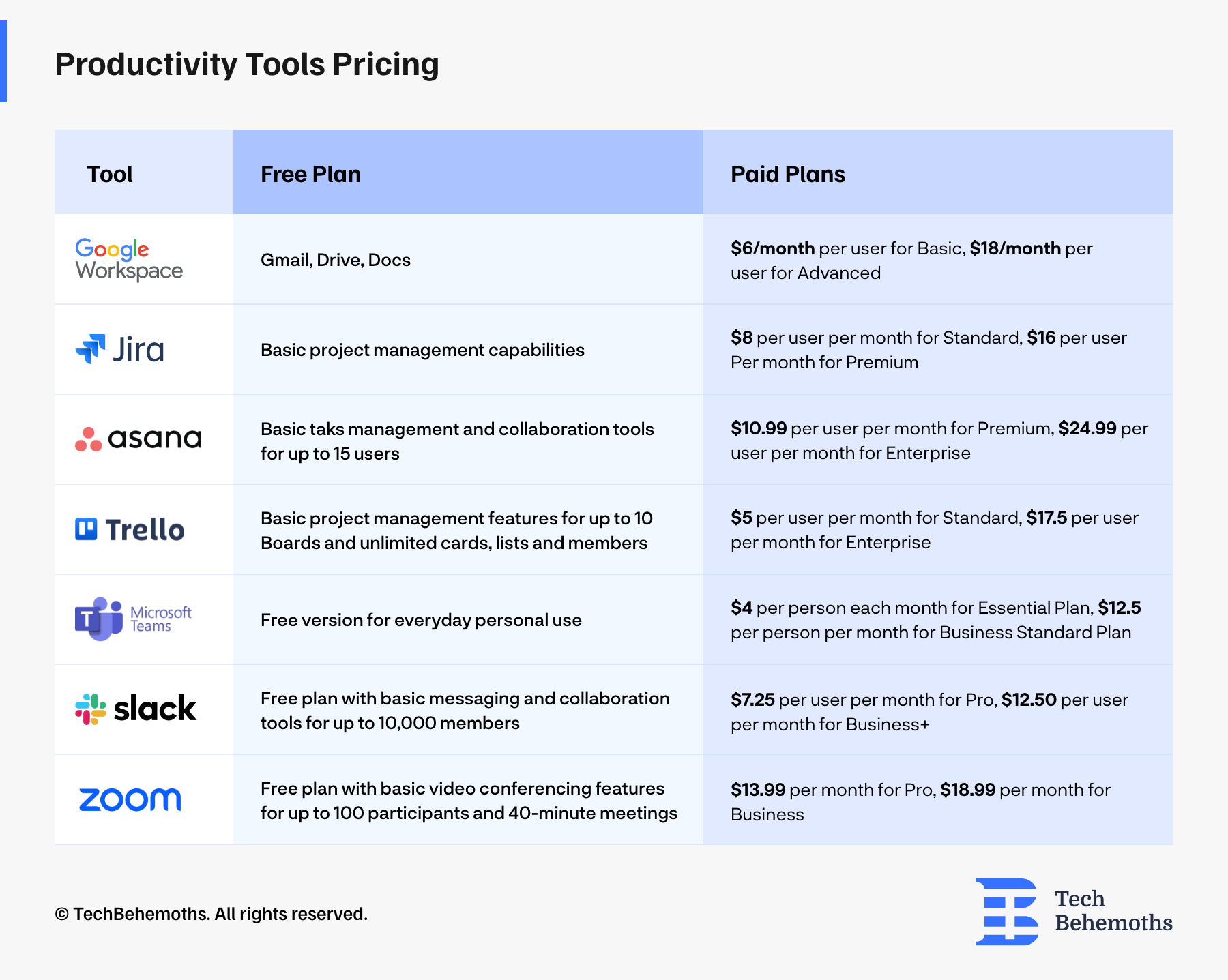
Important to remember is that the provided pricing details can change meantime, so it's a good idea to verify the latest information on the official websites. Also, many of these tools offer free trials. Take your time, and test them before deciding on a paid plan.
Conclusion
By considering all these factors, you can decide which productivity tool you like best, which features you want to benefit from, and which pricing plan is the best fit for your team.
If you're interested in exploring this topic further, we invite you to read our latest survey and learn which productivity tools are considered top, how teams rate their productivity, and what makes them strong.
Do not be busy, Stay Productive!